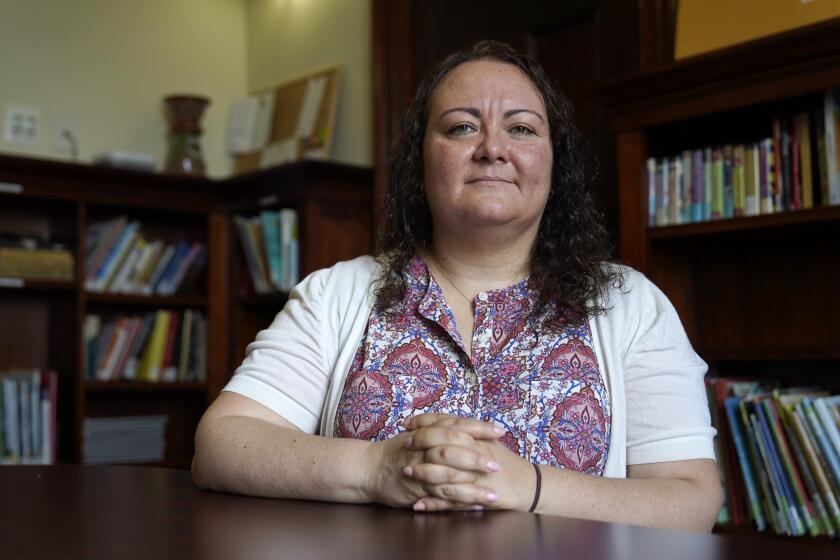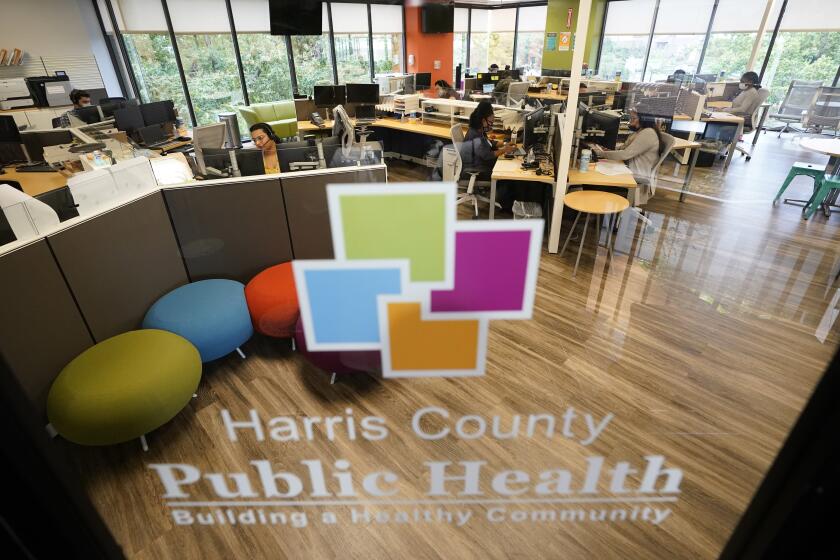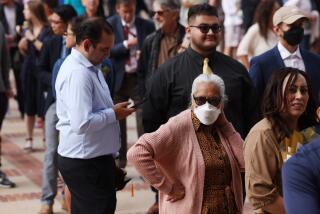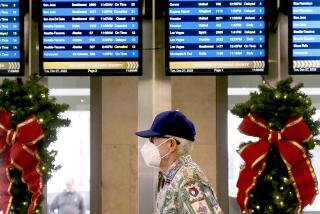L.A. County contact tracers struggle to reach, interview people with COVID-19
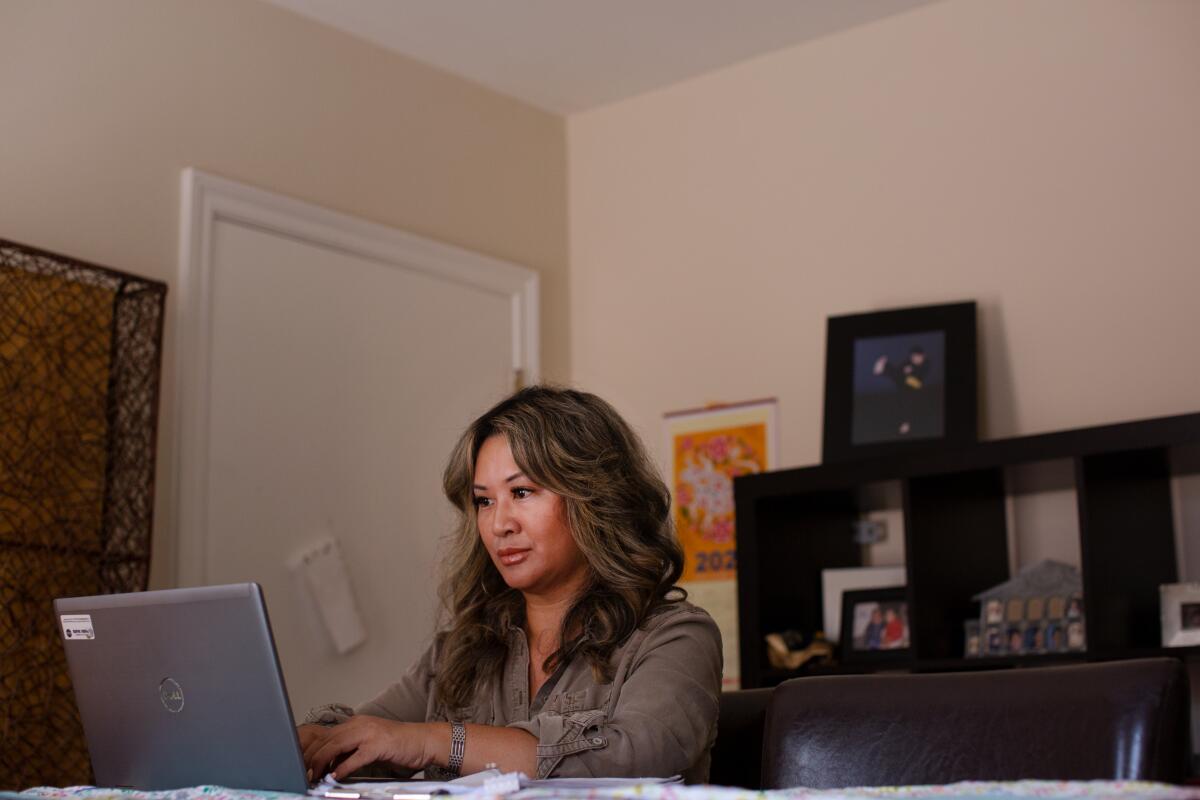
- Share via
Los Angeles County has continued to struggle to reach people infected with the coronavirus as the pandemic drags on, with contract tracers interviewing only around 40% of the people they were tasked with reaching during the last week of August.
That number has slumped since last summer, when contact tracers were interviewing as many as 70% of the infected residents whose cases they were assigned per week.
The contact tracing system — considered a key tool in slowing the spread of the virus — has faced obstacles from the start of the pandemic, when it repeatedly faltered in containing workplace outbreaks.
Now contact tracers, who are tasked with ensuring that infected people isolate themselves, notifying others who may have been exposed and offering county resources, are finding it increasingly difficult to reach people and get them to agree to an interview.
Public health officials worry that younger people — who now make up a larger share of coronavirus infections since seniors have gotten vaccinated at higher rates — may be less likely to answer a phone call from an unfamiliar number.
Contact tracers have started texting people as well, but sometimes “we call them three times in a row. We leave messages. We text them. And they call us back and tell us, ‘Take me off your list and stop texting me,’” said Gema Morales-Meyer, who directed the case and contact interview branch of the L.A. County Department of Public Health until earlier this summer.
“COVID fatigue” could also be a factor, officials say. Early in the pandemic, “even if they were reluctant, they did the interview because it was so new. It was novel. People didn’t know what was going on,” said True Beck, a COVID-19 response manager. Now that much of L.A. has reopened and people are spending more time outside their homes, they seem less likely to pick up the phone, Beck said.
Aiming to bring the numbers back up, public health officials launched a door-to-door effort to reach people this summer, which they hope will prove more fruitful. But door-knocking can take more time for workers who have to battle traffic and hunt for parking as they drive from address to address.
Vishia Tolcidas, who started working as a contact tracer in the spring, said some residents have been upset when she shows up in person. One woman told her: “It’s so inappropriate. You’re coming to the homes uninvited.”
“I said, ‘I’m just coming in to provide help,’” Tolcidas said. The woman replied, “I don’t need your help.”
Overall, more than half the people whose cases were assigned to L.A. County contact tracers between April 2020 and August 2021 were not interviewed, according to county data.
The weekly interview rate sunk below 25% at one point during the winter, when contact tracers were overwhelmed by a crush of new cases. After rebounding somewhat early this year, it has continued to sag this spring and summer, a Times analysis found.
The overwhelming majority of cases are now being “initiated” within 24 hours, which means someone has made a phone call or visited the person’s home, county data show. But “sometimes they would be so inundated with calls from friends or family that we couldn’t leave a message because the voicemail was full,” said Maureen Calderon, an L.A. County contact tracer.
When people do answer, Calderon said, some have been suspicious. She tries to put people at ease by handing over her number and extension, talking about assistance the county can offer and telling them an interview is voluntary.
“I don’t think people like to feel forced to do anything,” she said.
Coronavirus contact tracing is proving especially difficult in immigrant communities because of language barriers, confusion and fear of government.
The effort to track down and talk to those infected with the coronavirus has been a huge undertaking for the county, which had deployed roughly 2,800 contact tracers at the height of the pandemic, Beck said. (The number dropped as cases fell and was around 1,000 at the end of August, Beck said.) It sought out contract workers and interns, turned to volunteers from universities and reassigned county employees from other departments and divisions, pulling them from other work.
For every person they reach and interview, contact tracers could theoretically end up following the trail of many other contacts. But in L.A. County, only 43% of people interviewed had provided one or more contacts to tracers as of late August, according to the Public Health Department.
Morales-Meyer said some people may have shied from admitting that they had been mingling with other people. Some don’t want those contacts to know they have the coronavirus, she said, even though county tracers don’t tell people who might have exposed them.
The Times also found a sharp increase in March in the percentage of coronavirus cases that weren’t assigned to L.A. County’s main set of contact tracers. Morales-Meyer said that was largely due to a backlog of winter cases that had languished so long that the people infected were no longer supposed to isolate themselves.
In Echo Park, Madalyn Rofer-Choate said that last winter she didn’t hear from an L.A. County contact tracer until nearly a month after she had tested positive at Dodger Stadium. The call finally came after she was retested in late January and again turned up positive, she said.
“I was kind of dismayed that it took so long,” Rofer-Choate said. She added that there was no apparent call to her husband, who had tested positive nearly two weeks before her.
Health investigators are finding it nearly impossible to keep up with the deluge of new COVID-19 infections and carry out contact tracing efforts.
In another attempt to boost tracing, L.A. and California officials last year started promoting apps that can alert people through their smartphones when they have been near the phone of an infected person. The California app, CA Notify, has been used to alert contacts in roughly 88,000 cases, according to the California Department of Public Health.
That number equates to roughly 3% of the more than 2.75 million coronavirus cases reported in California since the app was launched, a Times analysis found. One hurdle has been that when app users test positive, they have to get and use a code to alert others, which some fail to do, said Christopher Longhurst, chief information officer for UC San Diego Health, which is helping assess its results.
But the app is now alerting an average of nearly five contacts per positive case — a much higher rate than has been typical for manual tracing in Los Angeles, Longhurst said.
“We believe that we’ve helped to avoid tens of thousands of infections and helped to avoid hundreds of deaths,” he said.
The quest to slow the spread of COVID-19 through contact tracing has been a difficult one across the United States. The sluggish turnaround for test results early in the pandemic, as well as the challenges in getting many people tested at all, made it hard for many health departments to intercept positive cases and help stop more infections, said Adriane Casalotti, chief of public and government affairs for the National Assn. of County and City Health Officials.
Many communities reopened in the spring before setting up rigorous programs for contact tracing, she said. And as the virus spread, it became harder for public health agencies to keep up with the sheer volume of cases.
Despite the challenges, contact tracing is still seen as a crucial way to thwart infections. One analysis performed for the Centers for Disease Control and Prevention estimated that when combined with measures such as masking, contact tracing averted anywhere from 4% to 97% of additional coronavirus cases that would otherwise be expected.
Times staff writers Thomas Suh Lauder and Sean Greene contributed to this report.
More to Read
Sign up for Essential California
The most important California stories and recommendations in your inbox every morning.
You may occasionally receive promotional content from the Los Angeles Times.
